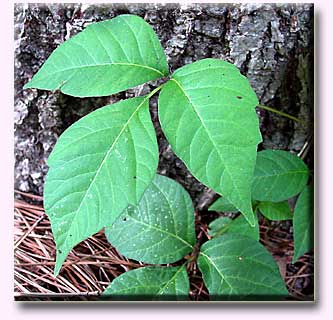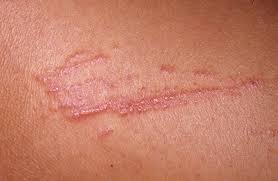Pesky Poison Ivy: Recognition, Prevention, and Treatment. By Our June Student Pharmacist, Rebecca Rady.
As we move into June, it’s official that the summer weather is here to stay! With the beautiful sun and warmer temperatures, many of us will find ourselves spending a lot more time outside in nature. Poison ivy and oak plants have their peak flowering season in central Ohio from May-July, so we wanted to give some handy tips on how to prevent, treat, and remove poison ivy should you come into contact with this irritating plant as you enjoy the outdoors.
Recognize Poison Ivy
The most important step in preventing poison ivy is knowing what the plant looks like and then, subsequently, avoiding it. There are many folk rhymes out there to help identify poisonous plants with the easiest being: “leaves of three, stay away from me” or “leaves of three, let them be.”
Poison I-V-Y and poison O-A-K plants each have three letter names, as well as poisonous leaves that are bunched in groups of three. If you come across any unfamiliar plant with a branch of three leaves….stay away!
Poison ivy plants have oil on their leaves that can cause dermatitis (an itchy rash) when it comes in contact with human skin. Some people are more sensitive to the plant oil than others. If two people touch the same plant, one person may get a widespread rash and another person may be completely unaffected.
Poison ivy rashes are usually red with white vesicles/blisters containing clear liquid and they are most well known for being extremely ITCHY. Rashes often appear in straight lines from where the poison ivy plant brushed up against the skin, but they can also be very widespread if the oil gets rubbed around the skin surface before thoroughly cleansing.
A common misconception about poison ivy is that the rash is contagious. The rash can NOT be transmitted from person to person and the rash can NOT “spread” once the oil is completely removed from the skin. A rash on the body only appears where the plant oil has come in contact with skin.
Treating Poison Ivy
If you come in contact with a poison ivy plant, the first step is to remove the oil from your skin. Wash any skin that comes in contact with the plant with cool water and a mild cleanser, such as Dawn, Cetaphil, or IvyCleanse. You can rinse the skin under water or rub lightly with a paper towel (throw away the towel after cleansing).
If a rash develops, it will be extremely itchy but it is important to try not to scratch. Scratching can break the skin and increase your risk for the rash to become infected by bacteria. To help ease a rash that is itching, you can put on a topical steroid cream or ointment such as Hydrocortisone 1%. To use this product, a thin film can be applied 2 to 4 times daily and the area should remain uncovered. This is a good product to use if you get a rash on your arms or legs, but hydrocortisone should be avoided under areas of tight clothing. Topical antihistamine creams (such as Benadryl cream or diphenhydramine cream) should be avoided on poison ivy rashes, because these products can sometimes cause additional skin irritation. You can always ask your pharmacist for help choosing the right product in the store or call and ask for advice on how to use the medication.
If the rash has vesicles or blisters that are leaking clear fluid, an astringent (like witch hazel or Burow’s solution) can be used to help dry out the area. As long as the rash is oozing, ointments should be avoided but steroid CREAMS can still be used on an oozing rash.
Skin protectant products (such as calamine lotion or colloidal oatmeal) are not very effective at preventing the rash from itching, they can be used to help soothe the skin and provide a barrier between the rash and the environment.
If you ever feel that a poison ivy rash is severe (interferes with daily activities, rash is spreading rapidly, rash covers over >25% of body) or involves mucous membranes such as eyes or mouth, seek medical attention from a doctor, nurse, or pharmacist. A severe rash may require a prescription strength topical product and/or an oral medication.
Getting Rid of Poison Ivy
If you find a poison ivy plant and want to get rid of it, it is important to take appropriate precautions to avoid contact with skin. To prevent the oil from touching your skin, wear long pants and sleeves as well as heavy-duty vinyl gloves because the plant oil can penetrate rubber gloves. In order to prevent the plant from growing back, pull up the plant from the roots and dispose of it inside of a garbage bag to prevent the oils from contaminating other surfaces.
If you would like to kill the plant before removal, you can pour boiling water over the plant or use a herbicide such as RoundUp. After the plant is dead, the oils may still be present, so you should continue to use a barrier between your skin and the plant. NEVER burn poison ivy in order to kill the plant. The irritating oils can become an aerosol, which can be extremely dangerous if inhaled.
Points to Remember
- Avoid coming into contact with poison ivy plants: “Leaves of three, stay away from me.”
- The poison ivy rash can NOT be transmitted from person-to-person once the oil is removed from the skin.
- There are many pharmaceutical products available to treat poison ivy rash including:
- Hydrocortisone cream is the best and safest OTC product for itching.
- Ointments, astringents, and skin protectants can also be used.
- Ask your pharmacist for help selecting a product!
- If a poison ivy rash is severe, the patient should seek medical attention.
- Never burn poison ivy when trying to eradicate the plant, as it can become an aerosol that can then be inhaled.
References
- The Great Outdoors: A Skincare Guide for Pharmacists. Pharmacist’s Letter. 2014. Self-Study Course #140211. http://pharmacistsletter.therapeuticresearch.com/ce/ceCourse.aspx?cs=student&s=PL&pc=14-211&pm=0&quiz=1#8497
- Poison Ivies, Poison Oaks, Poison Sumac. 2015. http://www.poison-ivy.org/poison-ivy-overview.
- Rhoades, H. Poison Ivy Control: How to Get Rid of Poison Ivy. Gardening Know How. Last updated: 04 June 2015. http://www.gardeningknowhow.com/plant-problems/weeds/poison-ivy-control.htm



